Introduction
Like it or not, SEO is an integral part of the online business realm. Any merchant that seeks to attain even a modicum of success must learn to navigate the deep and ever-changing waters of SEO.
To help build a solid foundation for understanding the discipline’s inner workings and to dominating the SEO arena in 2019, let’s start at the beginning with what SEO is exactly.
Definition of SEO
Broadly speaking, SEO – which stands for search engine optimization – is a set of tactics and strategies to help web pages rank higher in search engines like Google, Bing and similar platforms. Defined more narrowly, SEO aims to tweak specific factors known to impact the authority of particular pages that compete against a myriad of others, all vying to dominate the same keywords and phrases relevant to a given search query.
In practical terms, SEO is the process by which webmasters seek to increase the quantity and quality of visitors to various web pages by obtaining heightened visibility. This enhancement is achieved by ranking higher in the SERPs (search engine result pages). Through higher rankings, brands can attract more qualified visitors who are in search of products, services and solutions that a company offers.
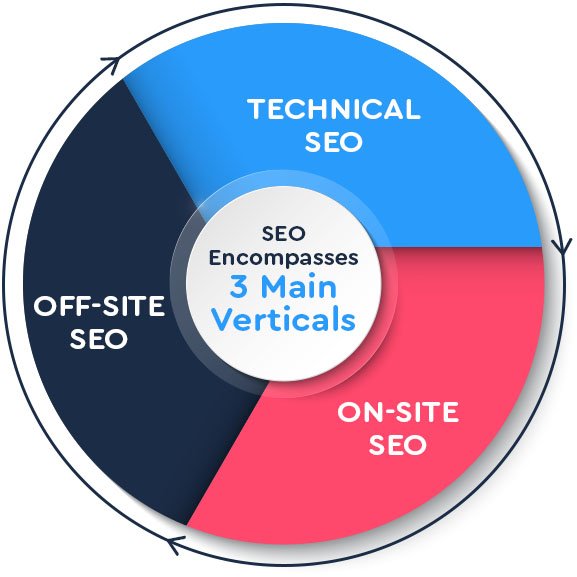
SEO encompasses three main verticals:
- Technical SEO: This aspect helps to ensure that search engines are capable of crawling and indexing pages within a website without complications. Technical SEO elements include a website’s structure, backend files, tags and similar components.
- On-site SEO: On-site SEO aims to provide search engines spiders (or crawlers) with enough signals to adequately understand a page’s content and context. On-site SEO focuses efforts on keywords, headings, internal linking strategies and other signals for search engines to read.
- Off-site SEO: This facet is everything that occurs outside of a website that can influence search engine rankings including backlinks, social media mentions, influencer marketing efforts and similar strategies.
With this foundation in mind, let’s explore why SEO is a necessary strategy for ecommerce merchants to master.
The Importance of SEO
The primary goal of SEO is to elevate a webpage to the top of the SERPs for specific queries. The more optimized a page is, the higher it is likely to rank in search engines. Achieving top rankings for particular keywords and queries is essential as the majority of search engine users never go beyond the first page. In fact, the first page captures between 71 and 92 percent of clicks with the top three results pulling in the most users. Therefore, merchants always want to rank as close to the top of the SERPs as possible.
Moreover, ecommerce purveyors are continually aiming to be listed before competitor sites as this increases the chances of garnering sales and earning new customers.
In today’s exponentially more competitive ecommerce landscape, SEO is more important than ever as search engine users are more trusting of websites that exist in the top seats of the SERPs. Moreover, SEO also encompasses a user’s experience on a website, which drastically impacts perception and sales.

Because of these critical considerations, SEO is vital to the success of today’s online businesses.
To start understanding how to increase a store’s SERP rankings, it is first necessary to look at how Google analyzes and positions the sites in its engine.
Google’s Ranking Algorithm
Google’s ranking system sifts through literally hundreds of billions of web pages that are listed in the company’s index to provide search users with the most useful, valuable and relevant results possible.
Google’s ranking system incorporates a series of algorithms that analyze and weigh over 200 different ranking factors to determine how to organize and return various pages to a user for a given query.
The key to providing useful results for users lies in understanding the meaning of a search and the content that relates to that query. Therefore, Google’s first step is to analyze the searcher’s question and what it means. Thanks to the intelligent and sophisticated machine learning language models, the search engine can interpret a user’s needs and seek out relevant web pages with information that will serve the searcher’s request.
Google’s algorithm searches through its index to surface appropriate pages, which are then analyzed for keywords, headings and similar relevancy elements. However, given that potentially millions of pages are likely to be relevant to a given search, Google then applies its algorithms which evaluate the usefulness of each page. At this stage is where the search engine considers hundreds of different factors such as domain authority, user experience, the freshness of content and a cornucopia of other signals. One of the single most influential of these ranking factors is something that Google calls RankBrain.
RankBrain is Google’s machine-learning artificial intelligence system that’s used to help process its search results and identify the most relevant content and online destinations to search engine queries. RankBrain helps Google establish and incorporate in a meaningful way unique elements like the location of the searcher and the words of the query to determine the searcher’s intent. Part of how Google determines user intent is that RankBrain studies how users interact with various search results and ranks them accordingly.
For instance, if a search engine user clicks on a page and immediately leaves, this indicates to Google that the page was irrelevant or of low value, and it should, therefore, lower the ranking of the site for such queries. These types of signals (such as time-on-site and number of people that click on a webpage) inform Google on how popular and useful specific pages are in relation to a searcher’s intent.
While Google announced in 2015 that RankBrain was its third most important ranking factor, the system is less a signal and more a means of processing information.
However, the inclusion of this massively influential ranking factor has nonetheless forever altered SEO practices, as we will see later.
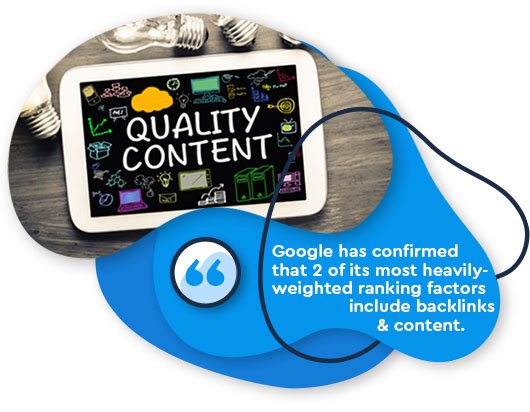
Outside of RankBrain, Google has previously confirmed that two of its other most heavily-weighted ranking factors include backlinks and content. Both of which we will cover extensively later.
With the SEO landscape laid out before us, let’s dive into the technical side of SEO and learn how to conduct an audit and optimize a website effectively.
SEO Audits
For the uninitiated, an SEO audit serves to provide retailers with performance insights for a website and individual pages, helping to provide a roadmap to attaining better rankings in the SERPs.
An SEO audit aims to identify problems that need to be fixed or areas in which improvements can be made.
To get started, conduct a crawl of the site using tools like Screaming Frog SEO Spider Tool, Ahrefs, SEMrush or a similar platform.
During this process, merchants will need to conduct a technical audit as well as a backlink audit.
Technical Audit
A technical audit will help merchants establish areas of a site where search engines are having difficulty crawling.
There are a variety of aspects involved in a technical audit that will require examination.
Indexation/Accessibility
The first step of this process is to analyze which pages of a site have been indexed by Google. If a page hasn’t been indexed, it cannot be ranked or accessed by search engine users, potentially causing significant problems for a site.
Indexation Reports
To establish this information, go to Google Search Console and pull indexation reports by heading to Google Index > Index Status. From here, cross-reference this information with the number of internal pages found during the site crawl ran earlier.
These numbers should be extremely close to the total number of pages on the site (minus those purposefully excluded such as terms of service pages). If there is an unexpected gap, merchants should review their disallowed pages.
Robots.txt
If you’ve established that all your site’s pages that should be indexed are not, the first place to seek answers is the robots.txt file. This file is essentially a tool webmaster leverage to tell search engine spiders how to crawl specific web pages within a site. Therefore, robots.txt can instruct Google not to crawl pages altogether.
When examining the robots.txt file, look for “Disallow: /” as this is the command that tells search spiders to refrain from crawling a page or entire site. Ensure that none of your relevant pages have been inadvertently disallowed.
Similarly, it is essential to disallow any pages that provide little or no SEO value.
Sitemaps
Sitemaps are essential for proper crawling as these inform search spiders about a site’s structure and enable them to find new content quickly.
When conducting a technical audit, it is vital to ensure that a proper sitemap has been submitted to Google and is accessible through a direct URL.
Moreover, it is important to inspect your sitemap to determine if there are any pages present in the crawl that do not appear on your sitemap. If this is the case, the map needs updating. Conversely, if there are pages in the sitemap that do not appear in the crawl, it is essential to determine why they are not surfacing. Finally, verify that the map flows in a logical format to help spiders crawl the site efficiently. More on that later.
Go to Google Search Console > Crawl > Sitemaps to compare the URLs indexed in the sitemap to the URLs in the web index.
Redirects
During this portion of the audit, if any pages return errors, these must be fixed. If a URL is broken, it should be redirected to a relevant webpage.
When implementing 404 redirects, always divert these pages to destinations with content. Moreover, any 302 redirects in use should be converted to 301 redirects to effectively pass on the link equity to the new page.
Crawl Budget + Bloat
Crawl budgets are the number of pages that spiders will crawl during a given period and determines how often the site’s most important pages will be crawled. Merchants can gain some understanding of their crawl budget by going to Google Search Console > Crawl > Crawl Stats.
Indexation bloat occurs when a site features pages within a search engine index that should not be present; this can cause crawl issues if not properly monitored and maintained.
There are quite a few strategies that retailers can implement to make the most of a crawl budget and reduce bloat; using this budget efficiently is essential for ecommerce sites with tons of pages. To maximize a crawl budget:
- Eliminate duplicate content
- Disallow pages with no SEO value such as privacy policy pages.
- Fix broken links
- Repair redirect chains
Redirect chains are of particular importance as these are a massive waste of crawl budgets. If an excessive amount of consecutive 301 or 302 redirects build up, spiders will stop following the chain, potentially causing the destination page not to get crawled.
Site Architecture / Linking
A site’s architecture or structure refers to its vertical and horizontal design. This arrangement is an essential element in making content easily discoverable by search bots.
Structural Hierarchy
A site’s hierarchy is naturally the site’s vertical depth and horizontal width. For ecommerce sites that possess a large number of pages, keeping the site’s structure as flat as possible is ideal. Organizing a site in this way ensures that important areas of the site are never more than three clicks away from any page.
The best way to implement a linking strategy that follows this structure is to move from home > category > product. Moreover, ecommerce sites should link horizontally as well, meaning that categories should link with other relevant categories and products should connect with other related merchandise.
Number of Links
Retailers should take the time to go through their site structure to see how many clicks it takes to get from the homepage to their most essential destinations; again, it should take users no more than three clicks.
Moreover, merchants will be required to examine the number of links on each page. A good benchmark is to keep this number under 100.
Contextual Links
Contextual links are links contained within content that point to relevant pages. Therefore, sellers should ensure that content includes a link to relevant pages that relate to the topic at hand. For instance, a product page for women’s shoes can link to “women’s socks.”
Footer
External links should never be placed in the footer as these often carry no SEO value. However, for user experience purposes, the most important pages of a site should be featured in the footer. For ecommerce sites, this will most likely be category pages, blogs and the like.
Click-Depth + Page Equity
As mentioned before, the most important pages within a site’s structure should be reachable within two to three clicks from the homepage; therefore it is vital to minimize the number of clicks required to reach important landing pages.
This condensation is critical as it helps to provide a streamlined user experience which effectively helps to reduce bounce rates.
However, in working to achieve this number, merchants should avoid building a structure that is great for users yet impedes the flow of page equity to the sites most valuable destinations.
Page equity is how pages pass authority from one to another, helping to increase their SEO value.
Equity tends to concentrate on homepages. Therefore, it is vital to create a clear, clickable path down to all essential pages on a site as this will move equity from the homepage on down to other pages.
The passing of SEO “juice” is the exact reason for the three click structure that follows the home > category > product pathway.
Site Speed
Site speed is critical to success as pages that take too long to load will be abandoned. 40 percent of consumers will bounce from a site that takes more than three seconds to load. On mobile, that number jumps to 53 percent.
High load times equate to high bounce rates; it’s that simple.
Optimal Speed
Speed is one of Google’s ranking factors on mobile and desktop. Therefore, site’s that take more than one and a half seconds to load should aim to make repairs quickly.
To test your site’s speed, use Google’s PageSpeed Insights tool.
Fixing Site Speed
The great thing about using PageSpeed Insights is that Google will provide retailers with actionable insights about how to repair their site’s speed ailments.
However, if Google’s advice doesn’t do the trick, site owners can take a variety of steps to improve load times such as:
- Enable compression
- Enable caching
- Optimize images to be less than 150kb
- Remove unnecessary plugins and files
- Verify the site host is on a fast server
On-Page Optimization
How pages are optimized has a massive impact on their ability to rank.
The most influential on-page elements that affect search engine rankings include:
Title Tags
Titles are an incredibly important element for on-page optimization. Page titles are the blue-linked text that appears first for search results. These are what most people will first notice and will potentially drive a click-through.

Titles tags should be roughly 55 – 60 characters long; any longer and they will likely get cut off. Moreover, titles should be optimized for specific keywords. These words should be placed as close to the beginning of the title as possible. Furthermore, it is important to include the company’s name at the end of the title.
When auditing the site, be sure to verify that no replicated tags are in use.
Meta Descriptions
Meta descriptions are the snippet of text just below the title. While this information does not directly influence search engine rankings, it does help users determine if they will click a webpage and that does impact rankings.
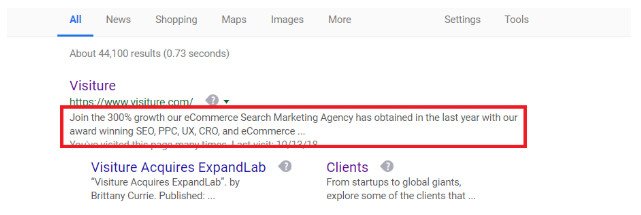
For this reason, meta descriptions should be concise yet engaging summaries of the content featured on a page. While the allotted length of these has fluctuated within the past year, at the time of this writing, best practices dictate that merchants keep meta descriptions between 120 and 155 characters.
Finally, be sure to include keyword modifiers and a CTA in this text to drive informed clicks.
URLs
It is also necessary to examine your URL structures to ensure that you are crafting keyword-optimized and descriptive arrangements as Google has stated in the past that the first words in a URL are weighted more heavily.
Additionally, URLs should be limited to 155 characters or less. Therefore, creating short, sweet, keyword-targeted URLs is essential.
Images
Since Google is unable to see images (as of yet), providing the search engine with the necessary data is vital. The two main components for informing search engines about an image’s content are the file name and the alt text. Both fields should:
- Be concise, descriptive and accurate
- Incorporate keywords naturally
- Use hyphens as separators instead of underscores
Moreover, merchants should aim to maximize page speed by scaling images down while still maintaining quality. Some useful tools for this include:
Sub-Heading Optimization
Naturally, retailers should leverage sub-heading tags to structure on-page elements. In HTML, these are known as H2 or H3 headings.
To properly optimize sub-headings, it is necessary to include a targeted keyword. While you shouldn’t stuff or overuse keywords, it can be helpful to include them in one or two subheadings.
Content
When performing an SEO audit, analyzing the website’s content is an essential task as there is tons of optimization value to be had here.
Homepage
The homepage will be the starting point for most consumers and will be where most of a site’s SEO juice is likely to pool. For this reason, the homepage should be one of the site’s more optimized and refined destinations. Therefore, the homepage should be current and extremely easy to navigate.
When visitors land on your site’s homepage, navigating to category and product pages should be a no-brainer. Achieving a streamlined layout is essential for user experience and search spiders, both of which heavily influence SEO.
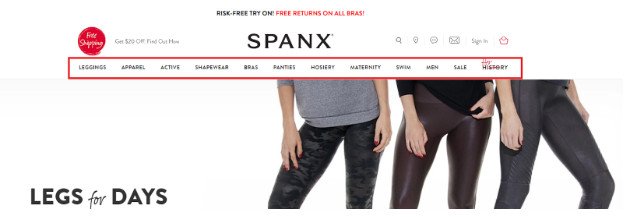
In addition to building an easily-maneuverable homepage, it should contain a small bit of content (a few short paragraphs are fine) that incorporates top-level keywords and is wholly unique to any other page on the site
Product Pages
The content present on product pages should be unique to your site. An incredibly pervasive SEO issue in the ecommerce community stems from product pages as scads of sellers feel that it is acceptable to copy and paste product info directly from manufacturer websites. This duplication can be extremely harmful to a site’s SEO performance as it creates duplicate content.
More on duplicate content momentarily.
Readability
As user experience is deeply intertwined with SEO, Google does take into consideration how easy it is for consumers to find the information they are looking for on websites. Therefore, content should be well-organized and easy to read.
Formatting content in such a way can be uncomplicated and somewhat intuitive. To ensure content’s readability employ short sentences and simple words, utilize a font that is large enough and easy enough to read and leverage bullet points and numbering.
Usability
A site’s usability will be determined by its audience. Therefore, merchants should reference Google Analytics to examine usability metrics like time on page, pages per session, bounce rates, click-through rates and similar measures.
By analyzing the increases or decreases in these data points, retailers can match up changes to alterations to determine if their site’s usability has improved or still needs improving.
Duplicate Content
Duplicate content is a common issue that can have a significant negative impact on SEO performance. For this reason, it is crucial always to feature unique content in all areas of a site.
To verify that there are no duplicate content issues on your site, it is wise to employ platforms like DeepCrawl as this is a useful tool for surfacing duplicate content complications.
Common duplicate content issues include duplicate titles, meta descriptions, domains and subdomains.
If retailers find duplicate domains, this can easily be remedied by adding a canonical tag to a page to indicate to Google which is the preferred URL. Additionally, URLs can be disallowed, as covered earlier. Finally, if a site features duplicate meta, product or similar descriptions, merchants can rewrite the content to resolve the issue.
Thin Content
Thin content is content that has little or no value to users. This content – which includes similar content and pages with scraped, duplicate or otherwise low-quality content – can be targeted and penalized by Google’s Panda algorithm.
When conducting an SEO audit, it is vital to identify and address thin content. For ecommerce sites with lots of pages, this will take some time and effort.
To start, go through web pages individually to target:
- Pages with little to no text
- Pages that feature auto-generated content
- Duplicate content (as described above)
- Pages with high bounce rates
- Pages published long ago that have no traffic
Aside from adding original and valuable content where possible, the best strategy is to de-index such pages by employing a “noindex” header tag and removing them from a store’s sitemap. For pages that are old and no longer garner traffic (such as an outdated promotion), these pages can be safely deleted and removed from the sitemap.
Content Pruning
Many merchants think that the best way to oppose thin content is to possess a superabundance of it. However, more content is not always a sound strategy. Enter: Content pruning.
The idea behind content pruning is to remove old, low-quality articles as a means of ridding a site of clutter while aiming not to damage the site’s quality as a whole. While this can certainly be an effective strategy for increasing traffic, merchants should err of the side of caution by attempting to revamp content before removing it altogether as an improperly managed pruning process can damage a site’s performance.
Mobile
Mobile has become an increasingly important and influential part of the SEO landscape. For this reason, it is an element that just cannot be ignored.
Mobile First
In early 2018, Google began rolling out its mobile-first indexing algorithm. This announcement has had profound implications for SEO communities as the mobile-first index means that Google considers mobile-friendly websites first when deciding how to rank content.
This alteration to Google’s algorithm means that possessing a mobile-adept site is critical to performance.
To analyze a site’s mobile SEO performance, start by leveraging Google’s mobile-friendly test tool by merely typing your site’s URL into the search box and clicking “Run Test.” Doing so will return a report dictating if a website is mobile-friendly or not.
However, this test is merely the starting point. The next step is to determine if Google can successfully crawl the mobile site. To do this go to Google Search Console > Crawl > Crawl Errors > Smartphone. Taking these steps will display a graph and table showing any potential errors.
Backlink Audit
As mentioned earlier, backlinks are one of the most influential SEO aspects that Google’s algorithm takes into account. Therefore, it is vital to review a site’s backlink profile after completing the technical audit.
Here are the elements that you will want to analyze and adjust during a backlink audit.
Low-Quality Links
Not all links are helpful. Links that are low quality do not contribute to the overall health of a website. For this reason, merchants should evaluate their backlink profile using one of the crawling tools mentioned at the beginning of the SEO audit section to pinpoint any links with a Domain Authority (DA) of 10 or less. These backlinks should be disavowed as they are likely harming a site’s SEO performance.
Non-Relevant Links
In addition to low-quality backlinks, non-relevant backlinks contribute nothing to a site’s SEO standings. If retailers see that they have backlinks from sites that are not relevant to their own, these too should be disavowed.
Bad Link Tactics to Avoid
In addition to disavowing any harmful backlinks, merchants must build links properly to gain SEO benefit from them and not receive penalties from Google. Some of the most common linking strategies to avoid include:
- Buying links: This tactic is inefficient and can result in a penalty. Considering that the new Penguin algorithm is real-time, using controversial link building practices can bring about an immediate drop in rankings.
- Using low-quality directory links: Theses fall in line with the low-quality links covered above.
- Hidden links: This is essentially a link that matches a page’s background color. This tactic is old and doesn’t work, so don’t do it.
- Creating private blog networks (PBN): A PBN is a network of blogs that have been created for the sole purpose of building links between each other. Google spiders are always on the lookout for these platforms and will penalize the site behind them.
- Guest posting too often: Don’t guest post just for a link. Guest posting is about building relationships.
- Using link exchanges: Link exchanges are considered an unnatural link building tactic and can affect your rankings negatively. Google can identify high levels of transferred links between sites and will penalize them as a result.
There are plenty of other lousy link building strategies to avoid, but these are rather common examples that webmasters still try to use.
SEO Research
As with any strategy, to develop a practical course of action, it is necessary for retailers to research a variety of areas.
Keyword Research
Despite the evolution it has undergone, keyword research is still an essential cornerstone to an effective SEO strategy.

Conducting keyword research helps retailers to uncover valuable words, terms and phrases surrounding various content, concepts, products and services ecommerce merchants provide. While keyword research can be a time-consuming endeavor, there are a variety of useful tools to aid in the process. Some stellar options include:
Depth of Keyword Research
When considering how deep you should dig into your keyword research, start by compiling a list of products and relevant topics to your brand as this step will help to create separate buckets that retailers should address during the investigatory process. You’ll likely develop several categories for keywords such as:
- Keywords for blogs
- Keywords for pages
- Keywords for products
When evaluating potential options, merchants should assess keywords through a series of criteria to help various forms of content rank. Some of these measures are:
- Website Relevance: The compatibility of keywords with a site and its products.
- Search Volume: A high exact match search volume is ideal.
- Ranking difficulty: Good keywords to target should have a relatively low difficulty score.
Moreover, it is vital to build a good mixture of head terms (short, popular keywords that generate lots of search volume) and long-tail keywords (contains at least three words and is more specific but less competitive) as this will help craft a fruitful keyword strategy that serves short and long-term goals. This notion is mostly true because head terms are powerful but hard to rank for, while long-tail phrases are rich in intent and more accessible for scoring quick wins.
Additionally, be wary of keyword cannibalization; this incident happens when more than one page on a site is trying to rank for the same keyword, meaning that a website is competing with itself.
Diligently keep a spreadsheet documenting pages and the keywords they target to avoid this blunder.
Striking Distance Reporting
Striking distance reporting is an old, yet effective technique that can provide fast and meaningful results.
Striking distance keywords are words a site ranks for, but just off the first page. With a small tweak or optimization, brands can hit the first page, ultimately having a significant impact on their rankings through the increased visibility.
These keywords provide ample opportunity for generating quick wins. To identify striking distance keywords, merchants can use a tool like SEMrush and sort keyword positions to be less than 19 and greater than 10, thereby surfacing a list of ideal keywords that are ranking on page two or three.
From here, merchants will want to optimize various page elements for these terms. These components can include title tags, internal links and more.
Additionally, retailers can also boost rankings for these terms through content hubbing.
Content Hubbing
After identifying some high-volume striking distance keywords, retailers should look for keywords that could become a content category or “hub” that could potentially accommodate a variety of striking distance keywords, thereby elevating the entire “hub” of words.
After identifying a promising hub, merchants should then seek to optimize their pages for this grouping of words by increasing internal page links to content that ranks for those targeted keywords.
The next thing to do is to refresh the content targeting the keywords, work in some more semantic phrases and make the pages valuable to potential visitors.
Finally, begin generating new content that targets the hub of striking distance keywords to help brings these pages to the forefront of Google.
![]()
How Keyword Research has Changed
While it may seem that SEO is still about finding keywords and targeting them to death as a means of ranking, nothing could be further from the truth.
Since the introduction of Google’s Hummingbird algorithm in 2013, keyword research has become an entirely different animal. The hummingbird algorithm introduced the notion of “semantic search,” which enabled Google to interpret the intent of a user’s search query, thereby returning more relevant results to Google’s audience.
Because of this sophisticated evolution, formerly effective keyword strategies became antiquated and ineffectual. In today’s SEO landscape, Google is looking for web pages that match a user’s intent (to buy, to learn, etc.) and seeks out highly informative, accurate and comprehensive knowledge that will meet search needs in a single stop.
Therefore, keywords are only a small part of the equation in climbing the Google SERPs.
Competitor Research
In addition to seeking out keywords that will help elevate your brand, it is necessary to understand the strategies used by competitors.
However, the goal of conducting competitor research is not to emulate the enemy’s formula; well, not always anyway. The ultimate aim of performing such an analysis is to gain a comprehensive understanding of the competitive landscape so that merchants can:
- Identify where they fit into the environment
- Amplify their SEO techniques to compete with rival sites
- Recognize and capitalize on holes in the competition’s approach
Conducting competitive research can assist merchants in their keyword strategies by seeing what terms rivals rank well for and which they are missing out on altogether.
Moreover, by analyzing the competition’s content offerings, merchants can determine which topics are not being covered by competitors and how to develop more valuable content for the subjects they do discuss.
By building a content strategy in this way, retailers can use tools such as SpyFu or SEMrush to see where competitor backlinks are coming from, craft content that one-ups the competition and then attempt to earn similar links or links from those exact destinations.
An excellent tool for conducting competitive research on content is BuzzSumo as it enables merchants to analyze top performing content by topic or competitor, based on the number of social shares various pieces have received.
Optimizing On-Page SEO
With the research for your strategy complete, it’s time to apply much of what has been learned to optimize essential on-site elements effectively. Much of what will be optimized should be issues that were uncovered during the technical audit. This includes:
Schema Markup
To maximize SEO efforts, merchants should aim at providing as much information as possible to search engines. To this end, adding schema markup to a site’s HTML code helps spiders understand and present the information available, and more accurately match user intent with search results.
Moreover, including schema markup to a site’s coding improves how pages are displayed in the SERPs by enhancing the rich snippets that are shown beneath the title.
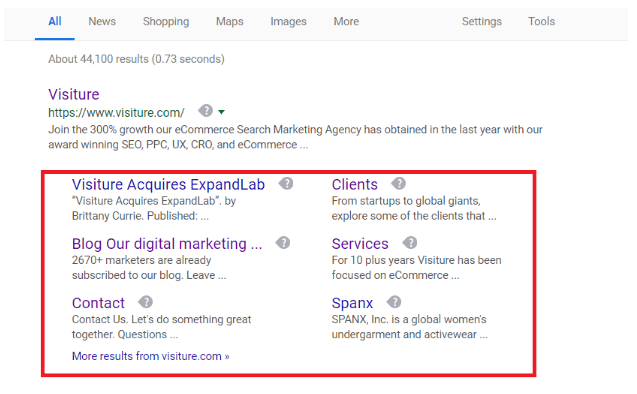
Product Ontology
Schema.org features the “additionaltype” property which enables retailers to amplify their detail for classification, which can ultimately assist with enhanced rankings by providing more information about ecommerce products.
Product ontology is essentially a dictionary that can be employed in schema.org’s additionaltype system. Using the 300,000 product definitions geared explicitly for e-commerce sites enables merchants to describe products in greater detail, thereby increasing their chances of ranking higher in the SERPs.
Site Architecture
A site’s structure is paramount to achieving full optimization. This is partly because of how visitors experience a website; if it is difficult to navigate, they will leave, increasing a store’s bounce rate.
Pyramid Structure
The pyramid arrangement is as bad as site structure can get for ecommerce sites as the pyramid structure often fosters mountains of pages with little to no content or pages that house duplicate content. As mentioned earlier, both issues can bring about penalties from Google. Moreover, search engines can have a challenging time crawling such sites and crawl budget can be quickly spent with this type of structure.
On the bright side, this is an issue that most all ecommerce brands wrestle with, meaning that the playing field is relatively equal regarding structure.
However, at Wpromote, we have found that optimizing the pyramid structure is dependent on creating links in the following way:
- Level 1: Homepage, 70 percent of backlinks
- Level 2: Categories, 15 percent of backlinks
- Level 3: Products, 10 percent of backlinks
- Level 4: Blogs, five percent of backlinks
Through this method, homepage links can share SEO juice with categories, products and blogs, thereby increasing the traffic and ranking these pages receive.
Breadcrumb Navigation
Breadcrumb navigation is a means of site navigation that displays where a user is within a site’s hierarchy.
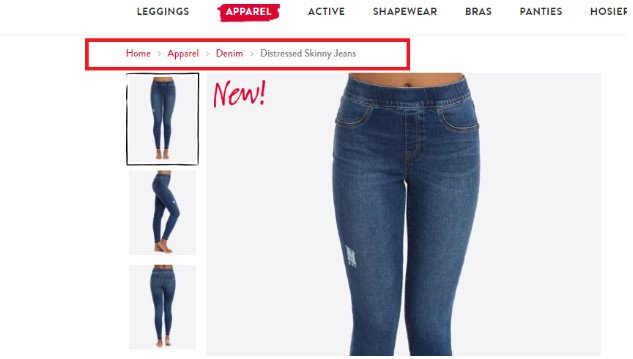
For example, at the top of a product page, it might read something like:

Site’s that feature a variety of product categories can simplify site navigation through breadcrumbs, helping to provide a better user experience. Moreover, breadcrumbs ensure that search engines understand a site’s structure, making them easier to crawl.
Breadcrumbs reduce the number of clicks users must make to get to various pages, which can help keep users from bouncing. Breadcrumbs are best used on sites with three levels or more, meaning that sites with flat structures likely do not need this feature.
Flat vs. Pyramid
Flat sites limit the number of pages a user must click through to obtain information or take a desired action. Flat structures are wide and short, making pathways efficient and intimately linked. For this reason, search engines have an easier time crawling and indexing flat site structures than pyramids.
The flat hierarchy works well for ecommerce sites that have distinct, recognizable categories as users won’t need to move through as many levels. When users know what they are looking for, they tend to jump right to that destination.
In either case, page depth is essential. Help users get from the homepage to the desired page in as few clicks as possible.
While each pyramid structures will be necessary for larger sites and flat hierarchies are ideal for smaller stores, each can optimize for page depth.
Mobile Friendly
Mobile is becoming increasingly crucial to ecommerce stores. According to 2018 holiday predictions from Salesforce, mobile devices will drive 68 percent of web traffic and 46 percent of sales.
This massive uptick in mobile ecommerce means that a responsive design is essential for success. In terms of SEO, Google has implemented a mobile-first index, highlighting the importance of mobile for ecommerce purveyors once again.
It doesn’t matter how you cut it: Mobile is an SEO necessity in 2019.
HTTPS
Stores that haven’t made the switch to HTTPS are way behind the times. In 2014, Google officially made HTTPS a ranking factor while marking any HTTP site that required passwords or payment information as “Not Secure.”
In 2019, it is necessary for ecommerce stores to move to HTTPS.
Page Speed
Given the nature of the digital age, speed is a massive factor in achieving the full potential of an SEO blueprint.
Not only does Google consider site speed a ranking factor, consumers demand it. 40 percent of desktop users and 53 percent of mobile consumers will bounce if a site doesn’t load within three seconds.
HTML
When optimizing on-page elements, there are several HTML components that merchants should assess.
Meta Titles
Again, meta titles don’t directly impact SEO, but they do help with crawling and enticing click-throughs. Therefore, retailers should optimize meta titles to provide Google and its searchers with proper information through the employment of keywords, CTAs and modifiers to earn clicks from consumers.
Meta Descriptions
These are quite similar to meta titles in that they don’t directly impact SEO efforts, but do affect a page’s CTR, thereby influencing search engine optimization outcomes.
Meta descriptions should include keywords and keyword variants, as well as CTAs and special offers or features of your company (like free shipping).
Subheadings (H2 – H6)
Headings and subheadings do have an impact on ranking pages within the Google SERPs. For this reason, pages should always begin with the <H1> tag. For all the other sub-sections of a page, the <H2> through <H6> tags should be leveraged accordingly, without skipping levels.
While merchants can use any number of H2 – H6 tags on any page, this can become somewhat cumbersome for a web designer if a significant number of tags beyond H3 are applied.
Alt Tags
Alt tags certainly don’t top the list for influential SEO elements; however, if merchants have the time and resources, these should be optimized.
Image alt tags should include relevant information about the image, keywords the page is optimized for and should be separated by hyphens.
Proper Tags
When optimizing on-site elements, retailers should go through all of their content to ensure that tags have been employed properly as Google should be able to quickly crawl a site and understand it well. Without the proper tags in place, the antithesis will likely happen.
This means that pages should be properly employing heading tags, with H1 tags used for category titles, while the H2 – H6 tags break up content accordingly. Moreover, paragraph text should feature the appropriate <p> tags on both ends.
Go through your site’s code to ensure that the proper tags are employed in the right places and that any unnecessary or potentially nonsensical tags are removed.
URL Structure
As is noted in the Search Console Help section:
“Overly complex URLs, especially those containing multiple parameters, can cause a problem for crawlers by creating unnecessarily high numbers of URLs that point to identical or similar content on your site. As a result, Googlebot may consume much more bandwidth than necessary, or may be unable to completely index all the content on your site.”
For this reason, Google prefers short, simple URLs. Whereas keyword-rich URLs used to reign supreme, Google now states that “a site’s URL structure should be as simple as possible.”
Moreover, Google also prefers when sites implement keywords closest to the beginning of the URL. Therefore, merchants should utilize a simple URL structure like example.com/category/product for product pages while using the similar example.com/blog/blog-name-here for content. The implementation of this structure will help cut down on the rise of duplicate content, mainly if merchants also utilize breadcrumbs and a sitemap accordingly.
Body Content
Body content is an area that ecommerce merchants tend to struggle with, either implementing duplicate, thin or far too much content.
Going into 2019, retailers should aim to optimize body content by only including material that is relevant to the category and current page. A few paragraphs of unique content should be enough not to impede the user experience or draw a penalty from Google.
Canonical Tags
Canonical tags are a necessity for reducing the potential of duplicate content. If your ecommerce store is already using canonical tags, feel free to carry on as usual.
However, with the importance of content marketing and PR in the ecommerce arena, be aware that if another source republishes content from your site, you need to ensure that publication is not given credit for that piece. Reach out to these sites and ensure that they attach a rel=canonical tag to the content, thereby giving your website the SEO juice for published work.
Interlinking
For those that are unfamiliar with the term, interlinking is the means by which webmasters link pages to other pages within the same website.
This is an important technique to employ as doing so can help merchants boost rankings for various pages. On the same token, retailers do not want to over-link; therefore, keep interlinks to about one per 100 words.
Mind you, interlinking is not merely about passing SEO juice from page to page; though, this is a part of it. Interlinking also helps to create a cohesive site structure and improve the user experience by allowing visitors to quickly move between connected pages, thereby increasing time on site and user satisfaction.
Usability
As mentioned numerous times throughout this guide, ecommerce websites must be user-friendly. When sites are designed with users in mind, visitors tend to stay longer, visit more pages and are more likely to purchase at the end of their session.
For all these reasons, merchants should review various usability metrics to identify where improvements can be made.
Bounce Rate
Bounce rates indicate the number of visitors who leave a site after viewing only one page. Review this data to determine how many consumers you are turning away, where you are losing them and how you can lower your bounce rate.
Information Acquiring
Google wants its user to acquire the information they are searching for from a single destination as this implies a stellar experience from Google and the visited site.
If your store’s content is not providing consumers with the answers they seek, pages will never reach the top of the SERPs. To optimize content to give solutions, aim to produce comprehensive content that covers a subject in an in-depth and informative manner.
Time on Page
This metric tells merchants how long a visitor stayed on a page. When visitors are on a page for a long time, this shows Google that the page is valuable and to increase its ranking.
This metrics is highly influential as it falls within Google’s RankBrain ranking factor, which is one of the top three elements considered.
Breadcrumb Navigation
Breadcrumb navigation helps to simplify the user experience by indicating where a user is within a site’s structure and how to get back to where they were.
This navigational feature assists consumers in moving easily moving between pages, thereby enhancing the user experience.
Mobile Friendliness
When speaking to mobile usability, most retailers are likely to adopt a responsive site design. While a responsive design makes it easy for users to interact with a site from any device and uses the same URL as the desktop destination, responsive sites offer less ability to customize the messaging and experience for mobile users. This drawback is important to be aware of as desktop and mobile users often conduct searches with different intents.
Additionally, responsive sites offer less ability to customize which resources are loaded, resulting in slower page loads.
Ensure that mobile speed is up to par by using Google’s mobile speed test and assess the metrics mentioned above on mobile to optimize small screen user experiences.
HTTPS
HTTPS is a significant usability factor as a GlobalSign study revealed that nine out of 10 internet users are more trusting of sites that display security markers, such as the HTTPS secure lock.

If a site does not appear to be secure, consumers will be less likely to interact with a store for fear that their information could be compromised.
Page Speed
No matter if we are talking about desktop or mobile versions of a site, speed should be a priority as slow-to-load sites will consistently turn away users and provide a poor experience.
Content
Creating valuable content is the cornerstone of all SEO efforts. As marketing expert Lee Odden once stated, “Content is the reason search began in the first place.”
Given this perspective, there are various ways in which retailers can leverage content for on-page optimization.
Category / Product Page Content
As mentioned numerous times, all of an ecommerce site’s category pages and product pages should feature unique content that targets relevant keywords while sharing important information about the category or product.
Again, ensure that this text is not too thin and is original to your site.
Blog
A blog is one of the most important assets an ecommerce store can possess in terms of SEO value.
Through creating blog content, retailers can improve rankings for keywords that are not applicable to the main site, provide value to their audiences and become trusted authorities within a niche and earn a variety of backlinks.
When crafting blog content, merchants should remember to follow guidelines to engender readability and to post new pieces on a consistent basis.
User-Generated Content
User-generated content posted through social media is a powerful driver for sales. However, it is also necessary to tout this type of material to optimize on-page efforts.
The most common form of user-generated content on websites is customer reviews. Product reviews are incredibly important for ecommerce sites to display 84 percent of consumers trust online reviews as much as recommendations from close friends. This dynamic means that the more positive user-generated reviews exist on a product page, the more likely merchants are to gain a sale.
When speaking to SEO, however, product reviews create a bevy of new content on sites and can often provide inspiration for blog posts, thereby serving a dual purpose.
Content Marketing
As content lies at the bedrock of a powerful SEO strategy, possessing an effective content marketing strategy is a must.
Content Creation
Content creation should never be guesswork. Retailers should leverage tools like BuzzSumo and Ahrefs to analyze content within their niche and establish what topics have resonated with consumers. This process applies to merchants themselves and competitors. Using this strategy to guide the creation process enables retailers to identify subject matter that is likely to perform well.
Moreover, when using topics that rivals have written about, it is imperative to find ways to enhance the content, making it more valuable to audiences and unique to your brand.

After establishing practical topics and writing useful content, insert relevant links with natural anchor text and send the materials off to design teams to generate visually compelling content. After all, nobody wants to read walls of text. Break up paragraphs with visual elements to improve the user experience and readability.
Above all, never lose sight of the fact that content should be written for the audience first, not Google. Always aim to produce high-quality content for your readers.
Content Promotion
Content promotion is a necessity for the materials to be of any use to your site. If pieces are not promoted, they run the risk of falling into the black hole of the internet.
Retailers must aim to get their content in front of the right readers. Here are a variety of ways to achieve that task:
Social Media
Social media is one of the most important content channels available as it possesses tremendous reach and provides direct lines to influencers. Here are some strategies for the most popular sites:
Facebook reaches over 2 billion people every day. For this reason, Facebook is a must.
To get your content in front of the right crowd, be sure to share your posts through your brand page. Moreover, merchants can boost Facebook posts to reach wider audiences.
Additionally, Facebook’s ad services can be an incredible tool for retailers. Learning to use Facebook ads is essential for broadening your horizons on the platform. When running ads campaigns, be sure to employ well-designed images, write intriguing copy and target the right consumers by using Custom and Lookalike Audiences.
Also owned by Facebook, Instagram has a massive audience and has been providing plenty of new avenues for merchants to drive traffic.
With Instagram, ecommerce merchants should employ adverts that feature stunning images, videos or even product collections.
Additionally, Instagram is the ideal platform to share user-generated content through, be it dedicated posts or in the form of Instagram Stories.
While influencers exist on all social platforms, Twitter is an ideal destination for reaching out to them to make a connection and potentially let them know about relevant content created by your brand.
On all the platforms mentioned thus far (but especially on Twitter) merchants should tag their content posts with relevant hashtags to increase discoverability.

Pinterest is an excellent platform for ecommerce merchants.
Given that all pins have separate URLs, brands can easily post stunning images that drive users to new content offerings.
Additionally, Pinterest ads are a great way to get content in front of new consumers.
With LinkedIn, merchants can leverage the platform’s dedicated content publishing tool, Pulse, to share content with like-minded audiences.
It can also be beneficial to join groups where retailers can connect with those who would be interested in their offerings.
However, given LinkedIn’s business-oriented nature, this platform is likely to produce better results for B2B brands.
Email Promotion
In addition to blasting out newly posted content to email subscribers, ecommerce purveyors should seek out authors, blog editors and influencers who have a particular interest in the topic covered.
When promoting in this fashion, it is essential to make a connection, so be sure to consume some of their content, let them know what you liked and why you think they might be interested in your content.
The aim is to hopefully get some of these connections to share your content on social media or link to it in one of their posts.
Advertising
Online advertising is effective, but it is not cheap. If your brand has the budget, it could be beneficial to promote content through Google’s Display Network and on social media (as mentioned earlier).
Linking Strategy
Backlinks are a strong ranking factor, so this step is vital to content marketing SEO efforts.
Relevance
Link relevance is paramount in SEO. If a link is irrelevant to your content or brand, it will not help your audience or your strategy. To determine if a link is relevant, merchants should use these benchmarks:
- Website relevance: Does the linking site share commonalities with your brand?
- Content relevance: Does the linking site post about similar or connected topics?
- Link relevance: Does the link’s anchor text, sentence or paragraph provide a connection to the content’s topic?
Good Sources
Relevance is only one aspect of a helpful link. Some of the other criteria that promoters will want to analyze include:
Domain Rating
Merchants can use tools like Ahrefs to determine a linking site’s domain authority. Sites that possess an authority of 10 or less will not help a store’s SEO efforts and could potentially harm rankings.
Social Influence
If a linking site’s social following has lots of engagement (likes, comments, shares), having a link shared on its page can bring a nice boost in traffic.
Alexa Rankings
Retailers can use Alexa to determine how well people interact with the site.
Ahrefs Rankings
Using Ahrefs, merchants can investigate a site’s authority, based on its backlink profile. In Ahrefs, the lower the ranking, the better.
Influence
This measure is more or less a compilation of all the other indicators analyzed thus far and is a subjective assessment of a site’s authority within a niche.
Number of Links
While possessing a large number of high-quality links is desirable, not all links can be superstars; in fact, having a fair amount of less critical links is necessary too. If you see you are getting links from sites with a domain authority under 35, that’s okay. The only ones you want to disavow are those that have a DA so low that it will hurt your site.
What is Impactful?
Here are a variety of elements that will help make links stronger:
Link Placement
Having a link towards the top of an article is best. Having more than one featured is even better. More than two, however, can prove to be less fruitful.
Social Signals
Having content shared across social media can result in authentic, high-quality backlinks from prominent and influential websites.
Email Click Backs
If an authoritative site shares your link in its newsletter and the link receives clicks back, this will amplify its clout.
User Engagements
The more users that interact with a link, the better it becomes.
Anchor Text
This element is only beneficial if the anchor is natural; otherwise, it may actually be harmful.
Anchor Content
The content surrounding the anchor – or the context – is equally essential as Google can perceive unnaturally placed anchors as spammy or suspicious.
Backlinks
The most influential factor is having backlinks point to your backlink as this indicated to Google that it is a good and reliable source.
Thought Leadership
Becoming a thought leader is massively important in the content marketing realm for every industry. Cultivating this attribute provides merchants with the credence to ensure that their store will be perceived as more credible and trustworthy. As a result, brands will tend to drive increased sales. All of this contributes to maximizing SEO efforts.
However, to become a thought leader, retailers must produce incredibly high-quality content that consistently answers questions, solves problems and enhances people’s understanding of a topic.
Analyzing SEO Efforts
While SEO might be an art, it is also a science. This means that they are a variety of metrics merchants can measure to determine if their efforts are succeeding or still need tweaking.
Here are the most critical data points to analyze to gauge SEO effectiveness:
Organic Search Traffic
Since the core aim of search engine optimization is to drive traffic to websites, retailers should be tracking the amount of organic traffic their site receives as a result of their efforts.
To determine if optimization efforts are taking root, it is necessary to compare a website’s traffic across time.

Since SEO results tend to be more of a slow burn than quick burst, the best way to measure traffic fluctuations is month to month.
To see how your site is performing in earning new traffic, simply go to Google Analytics and click Acquisitions > Overview.
Organic Revenue
For ecommerce websites, revenue is the ultimate goal; without revenue, retailers have no business. Analyze your site’s revenue to determine if your search optimization efforts are paying off.
Sales
As part of analyzing revenue, merchants will also need to track their sales. This metric can be set up in Google Analytics. Furthermore, site owners have two different ecommerce tracking options available to them:
Standard eCommerce
Using this data, retailers can monitor purchase activity through product and transaction information, average order value, ecommerce conversion rate, time to purchase and other reports.
Enhanced eCommerce
By using the enhanced ecommerce plugin, merchants gain information on when visitors add items to their carts, where in their shopping experience they initiated the checkout process and when they completed a purchase.
This info is vital for creating a better user experience.
Keyword Rankings
Monitoring keyword performance is necessary for refining a store’s strategy. Through Google Search Console, retailers can see which keywords are driving traffic to their site and how they rank for those terms. To obtain this information, click on Search Traffic > Search Analytics.
Number of Backlinks / Referring Domains
Since backlinks contribute to SEO effectiveness so heavily, ecommerce purveyors will want to keep a close watch on this metric. While more backlinks are better, some backlinks can be harmful and will require disavowing.
Through using a tool such as Ahrefs, site owners can see which websites are linking to their store, which page of their site is linked to and the domain rating of the referring site.
Click-Through Rates
It doesn’t matter how high your site ranks if it can’t generate clicks. This element is often influenced by factors such as meta titles and descriptions, so if a site’s CTR is low, this might be an area to investigate.
To analyze click-through rates, go to Google Search Console and click Search Traffic > Search Analytics.
Goal Conversion
Conversions are one of the single most important metrics to measure as clicks and traffic are meaningless if a site is incapable of converting. Mind you, converting doesn’t exactly equate to a sale, either. A conversion could be obtaining an email address, generating a download or meeting a similar goal.
Conversion Rate
In the ecommerce arena, conversion rates are the number of site visitors that become customers. Put another way, the conversion rate can be viewed the percent of visitors that buy. This metric is of the utmost importance for retailers to monitor.
However, it is also important to note that low conversion rates don’t equate to failure as it is necessary to account for the average order value of the conversions made. While a high percentage of conversions is desirable, it is not everything.
Average Time on Page
Equally as important as the number of consumers that visit your site is how long they stay on your store’s pages. Are visitors arriving and then leaving shortly after that or are they interacting with various components of your site?
Pages Per Session
In addition to average time on page, retailers should examine how many pages visitors are viewing after arriving on their site. If visitors look at various pages, this likely indicates that navigation is intuitive, interlinking schemes are working correctly and the content is engaging.
To analyze pages per session, head over to Google Analytics and click Acquisitions > All Traffic > Channels. This information can be found in the fifth column.
Bounce Rate
As mentioned earlier, bounce rates are the number of visitors that land on your site, only to leave after visiting a single page. A high bounce rate can be quite harmful to SEO efforts, so it is necessary to analyze this stat and figure out why you are losing visitors.
To view your site’s bounce rate, go to Google Analytics and click Acquisition > All Traffic > Channels and read the fourth column. This location will display a site’s bounce rate for each available channel.
To view the bounce rate for individual pages, go to Behavior > Site Content > All Pages.
Link Velocity
Link velocity is defined as the rate at which other sites are linking back to a retailer’s store. In other words, this is how fast a site’s backlink profile grows.
Backlinks should grow naturally over time. Therefore, if Google detects a sharp increase in a site’s backlink profile, there is a good chance it will appear suspicious and draw unwanted attention.
Backlinks should grow at a reasonable pace, so be sure to monitor this for any abnormal activity and ensure that your site’s backlinks are healthy and desirable.
Conclusion
SEO is a challenging discipline to master; however, it is one that is a necessity in today’s burgeoning ecommerce environment. To compete online with the myriad of other retailers and monolithic sites like Amazon, merchants must be capable of climbing the SERPs and getting in front of consumers. Without this ability, a website is likely doomed to fail.
Moreover, it is important to recognize that search engine optimization (and the practices that go with it) is a living, breathing thing, meaning that it is always changing. A site’s SEO work is never done as there is always room for improvement, changes to be made and new strategies to employ.
Learn to flex and bend with the constant changes of the SEO universe, and you hold the potential to one day dominate the SERPs.


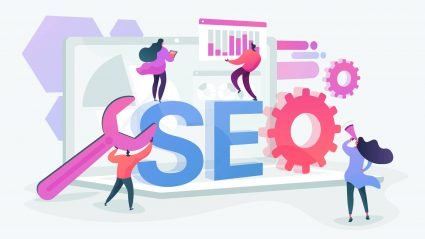



Responses